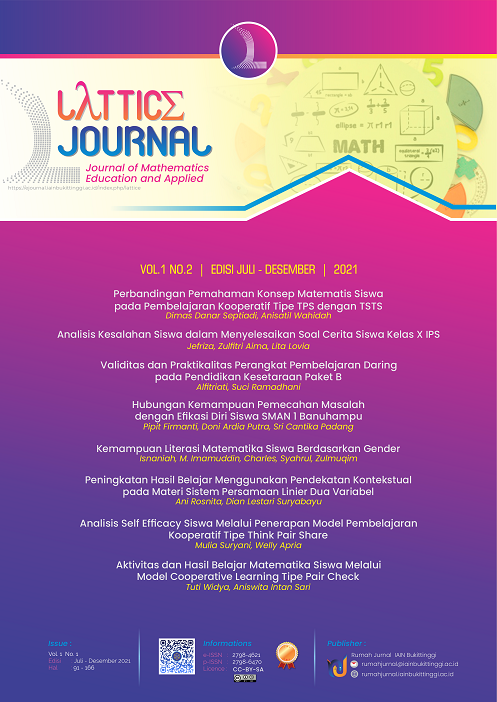Analisis Self Efficacy Siswa Melalui Penerapan Model Pembelajaran Kooperatif Tipe Think Pair Share
DOI:
https://doi.org/10.30983/lattice.v1i2.5163Keywords:
Cooperative Learning Tipe, Think Pair Square, Self Efficacy.Abstract
Self-efficacy of students in class XI TSM B SMK Negeri 1 Bukit Sundi is still low so it has a negative impact on self-efficacy and student mathematics learning outcomes. The purpose of this study was to determine how students' self efficacy after applying Think  pair square type cooperative learning models. This type of research is a descriptive method with a qualitative approach. The research subjects were all students of class XI TSM SMK Negeri 1 Bukit Sundi, amounting to two classes. The sampling technique is purposive sampling. The class chosen as the sample class is XI TSM B. To obtain the research data, an instrument in the form of a self efficacy questionnaire was used to interpret the self efficacy scores. The results obtained were 20% for the very strong criteria and 80% for the strong criteria, with an average of all indicators being 64.53% including the strong criteria. Dare to face the challenges is at the highest percentage with a percentage of 67.36% which is included in the strong criteria. He was sure that his success would be at the lowest percentage with the percentage of 60.19% and included in the strong criteria. It can be concluded that the students' self-efficacy during the application of Think  pair square type cooperative learning models in class XI TSM B SMK Negeri 1 Bukit Sundi Solok Regency with strong criteria on each indicator and needed continuous and continuous development
Â
Self efficacy siswa di kelas XI TSM B SMK Negeri 1 Bukit Sundi masih rendah sehingga berakibat terhadap hasil belajar matematika siswa. Tujuan penelitian ini adalah untuk mengetahui bagaimanakah self efficacy siswa setelah menerapkan model pembelajaran kooperatif tipe Think  pair Square. Jenis penelitian adalah penelitian dekriptif kualitatif. Subjek penelitian adalah siswa kelas XI TSM B. Untuk memperoleh data penelitian digunakan instrumen berupa angket self efficacy dengan cara menginterpretasikan skor self efficacy. Hasil persentase rata-rata seluruh indikator adalah 64,53% termasuk pada kriteria kuat. Indikator Berani menghadapi tantangan berada pada persentase tertinggi dengan jumlah persentase sebesar 67,36% yang termasuk pada kriteria kuat. Yakin akan keberhasilan dirinya berada pada persentase terendah dengan jumlah persentase yaitu 60,19% dan termasuk pada kriteria kuat. Dapat disimpulkan bahwa Self efficacy siswa selama penerapan model pembelajaran kooperatif tipe Think  pair square di kelas XI TSM B SMK Negeri 1 Bukit Sundi Kabupaten Solok dengan kriteria kuat pada masing-masing indikator dan diperlukan pengembangan secara terus menerus dan berkelanjutan.
References
A. Kanza, pengukuran self-efficacy siswa dalam pembelajajaran matematika di MTs N 2 Ciamis, vol. 1, no. 2. 2017.
D. M. Sari, “KEMAMPUAN PEMAHAMAN KONSEP MATEMATIS DITINJAU DARI SELF EFFICACY SISWA DAN MODEL PEMBELAJARAN THINK PAIR SHARE (TPS) DI SMP NEGERI 20 PALEMBANG,†vol. 12, no. 1, 2019.
O. F. Yanti, R. Charitas, and I. Prahmana, “Model Problem Based Learning dan Guided Inquiry,†J. Rev. Pembelajaran Mat., vol. 2, no. 2, pp. 120–130, 2017.
S. Aisah, H. Ashari, R. W. Akhdinirwanto, and V. No, “Penggunaan Model Pembelajaran Cooperative Learning Tipe Think pair square Berbantuan Kartu Soal untuk Meningkatkan Aktivitas Belajar Siswa Kelas VII B SMP Negeri 5 Purworejo Persentase Rata-Rata Aktivitas,†vol. 3, no. 1, pp. 16–18, 2013.
W. Fitriani, “ANALISIS SELF EFFICACY DAN HASIL BELAJAR MATEMATIKA SISWA DI MAN 2 BATUSANGKAR,†vol. 1, no. 1, pp. 141–158, 2017.
Destia Endah, Nila Kesumawati, Andinasari. (2019). Kemampuan Pemecahan Masalah Matematis Berdasarkan Self Efficacy Siswa Melalui Logan Avenue Problem Solving-Heuristic. Jurnal Nasional Pendidikan Matematika, 3(2), 207–222.
Fitri, Irma. (2017). Peningkatan Self Efficacy Terhadap Matematika dengan Menggunakan Modul Matematika Kelas VIII SMPN 2 Bangkinang. Jurnal Pendidikan Matematika, 1(2), 25-34.
Harry Putra, dkk. (2018). Kecukupan Data Pada Masalah Spldv Dan Self-Efficacy Siswa Mts. Jurnal Nasional Pendidikan Matematika, 2(1), 48–61.
Hilmi, Naihul. (2017). Korelasi Self Efficacy terhadap Kemampuan Penalaran Matematis Mahasiswa Semester Pendek Mata Kuliah Trigonometri Unrika. Pythagoras, 6(2), 143-150.
Ilfiya, D., & Noviyanti, D. F. (2017). Kajian Penerapan Teori Polya Dalam Model Pembelajaran Tipe Think pair square Untuk Meningkatkan Kemampuan Siswa Memecahkan Masalah Matematika. 211–216.
Riduwan. (2010). Belajar Mudah Penelitian Untuk Guru, Karyawan, Dan Peneliti Pemula. Bandung: Alfabeta.
Slavin, R. (2008). Cooperative Learning, Teori Riset dan Praktik. Jakarta:Nusa Media.
Subaidi, Agus. (2016). Self Efficacy Siswa dalam Pemecahan Masalah Matematika. Sigma, 1(2), 64-68.
Sumarmo, U. (2016). Pengembangan Dan Contoh Butir Skala Nilai, Karakter, Budaya, Dan Aspek Afektif Lain Dalam Pembelajaran Matematika.
Sumaryati, E. (2013). Pendekatan Induktif-Deduktif Disertai Strategi Think -Pair-Square-Share Untuk Meningkatkan Kemampuan Pemahaman Dan Berpikir Kritis Serta Disposisi Matematis Siswa SMA. Infinity Journal, 2(1), 26-42..
Downloads
Published
Issue
Section
Citation Check
License
Authors who publish with Lattice Journal : Journal of Mathematics Education and Applied agree to the following terms: Authors retain copyright and grant the Lattice Journal : Journal of Mathematics Education and Applied right of first publication with the work simultaneously licensed under a Creative Commons Attribution License (CC BY-SA 4.0) that allows others to share (copy and redistribute the material in any medium or format) and adapt (remix, transform, and build upon the material) the work for any purpose, even commercially with an acknowledgement of the work's authorship and initial publication in Lattice Journal : Journal of Mathematics Education and Applied. Authors are able to enter into separate, additional contractual arrangements for the non-exclusive distribution of the journal's published version of the work (e.g., post it to an institutional repository or publish it in a book), with an acknowledgement of its initial publication in Lattice Journal : Journal of Mathematics Education and Applied. Authors are permitted and encouraged to post their work online (e.g., in institutional repositories or on their website) prior to and during the submission process, as it can lead to productive exchanges, as well as earlier and greater citation of published work (See The Effect of Open Access).



